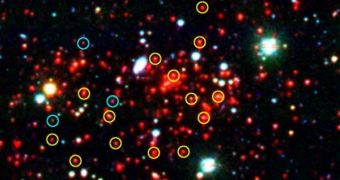Astronomers recently announced the discovery of an impressively-large cluster of galaxies in the early Universe, that has somehow eluded detection until now.
The cosmic formation was not detected directly, the experts say, but rather by analyzing distortions that it creates in the Cosmic Microwave Background (CMB).
The CMB is a faint glow that permeates the Universe, which is made up of photons released when the Big Bang exploded the Cosmos into being. It is one of the main pillars of the leading theory on how the Universe formed.
By looking at it, astrophysicists were able to determine the existence of the new galactic cluster, which was found lurking in the shadows some 7 billion light-years away from Earth.
According to official statistics, this is the largest galaxy cluster ever found to exist at such a great distance. Experts estimate that it weigh more than the mass of 800 trillion Suns.
They also believe that the formation is home to hundreds of large galaxies. They were discovered using the Sunyaev-Zel’dovich effect, which is the concept used to refer to the CMB distortions as the glow passes through matter to reach telescopes.
The South Pole Telescope is being regularly used to hunt this type of galaxy clusters, but the new one is definitely the largest experts using it have ever discover. It has been dubbed SPT-CL J0546-5345.
According to investigators, the cosmic structure may now be one of the largest clusters in the entire Universe, based on predictions of how it may have grown in the past 7 billion years.
Because of the large distance separating us from it, we only see the formation is it appeared before our solar system was even born, some 4.6 billion years ago, and when the Universe was only about half of its current age.
At the time, SPT-CL J0546-5345 was nearly as large as the Coma Cluster of galaxies, which is one of the densest such structure in the known Universe. Since then, the newly-found cluster may have grown denser, Wired reports.
In a paper published in the latest issue of the esteemed Astrophysical Journal, experts report that the new discovery could be used to study the effects of dark matter and dark energy on galaxies in the early Universe.

 14 DAY TRIAL //
14 DAY TRIAL //